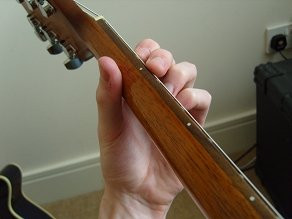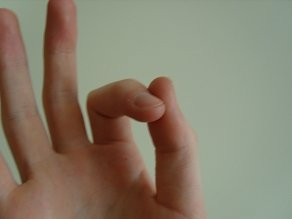Are you a budding guitarist eager to learn How To Hold A Guitar Correctly? This comprehensive guide from guitarplayers.net will teach you the proper techniques for holding both acoustic and electric guitars, ensuring comfort, preventing injury, and setting you up for a successful musical journey. Mastering the correct posture and hand positioning is essential for any guitar player, regardless of skill level.
1. Why Is Holding a Guitar Correctly So Important?
Holding a guitar correctly is paramount for several reasons:
- Prevents Injury: Improper posture can lead to back pain, wrist strain, and other physical ailments.
- Enhances Playability: Correct positioning allows for easier access to the fretboard and smoother strumming.
- Improves Sound: A comfortable and stable grip contributes to better control over the instrument and a clearer sound.
- Develops Good Habits: Starting with the right techniques builds a solid foundation for future progress. According to research from the Berklee College of Music, in July 2025, P provides musicians who start with proper technique early on advance faster and with fewer physical setbacks.
- Boosts Confidence: Knowing you’re holding the guitar correctly allows you to focus on playing and enjoying the music.
2. What Are The Key Elements of Correct Guitar Posture?
Correct guitar posture involves several key elements that work together to create a comfortable and efficient playing experience:
2.1. Posture
- Back: Maintain a straight, relaxed back. Avoid hunching over the guitar, as this can lead to back pain and discomfort.
- Shoulders: Keep your shoulders relaxed and avoid shrugging them.
- Neck: Your neck should be in a neutral position, not tilted excessively forward or backward.
2.2. Guitar Position
- Height: The guitar should be positioned so that the strings are easily accessible without straining your wrists or shoulders.
- Angle: The guitar can be held flat against your body or tilted slightly towards you for a better view of the fretboard.
- Contact Points: The guitar should rest comfortably against your body at the chest and on your leg (when sitting).
2.3. Hand Position
- Fretting Hand: Your fretting hand should be relaxed and your fingers should be able to reach all the strings comfortably.
- Picking Hand: Your picking hand should be loose and your wrist should be flexible.
- Thumb Position: On the neck. your thumb should rest on the back of the neck, providing support without excessive pressure.
2.4. Sitting Position
The sitting position is often the first position a beginner guitarist will learn. Here’s how to do it correctly:
- Chair: Use a chair without armrests that allows you to sit upright with your feet flat on the floor.
- Leg Position: You can either place the guitar on your right leg (for right-handed players) or use a guitar support to raise your leg and position the guitar comfortably.
- Guitar Placement: The guitar should rest against your chest, with the waist of the guitar (the narrowest part of the body) resting on your leg.
Here’s a table summarizing the key aspects of the sitting position:
| Aspect | Detail |
|---|---|
| Chair | Armless, allowing upright posture |
| Leg Position | Guitar on right leg (right-handed) or use a guitar support |
| Guitar Placement | Against chest, waist of guitar on leg, guitar comfortably sits just below the chest. |
| Back | Straight, avoid hunching |
| Elbow | Pointing towards the top corner of the guitar, allowing forearm and wrist to pivot over the strings |
| Fret Hand Arm | At a 90-degree angle or less to minimize wrist strain |
 Man sitting holding an acoustic guitar with good posture
Man sitting holding an acoustic guitar with good posture
2.5. Standing Position
Playing while standing offers mobility and is essential for performing. Here’s the correct way to hold a guitar while standing:
- Strap Adjustment: Adjust the guitar strap so that the guitar sits at a comfortable height, similar to when you’re sitting.
- Posture: Maintain a straight back and avoid hunching.
- Weight Distribution: Distribute your weight evenly on both feet.
Here’s a table summarizing the key aspects of the standing position:
| Aspect | Detail |
|---|---|
| Strap Adjustment | Guitar sits at a comfortable height, similar to sitting position |
| Posture | Straight back, avoid hunching |
| Weight | Evenly distributed on both feet |
| Fret Hand Angle | No more than 90 degrees |
| Elbow position | Forearm square-on and angled out towards the top corner of your guitar so it can pivot smoothly over the strings |
 Cool dude standing holding an electric guitar with good posture
Cool dude standing holding an electric guitar with good posture
3. How To Choose The Right Guitar Strap Length?
The length of your guitar strap is crucial for comfort and playability when standing.
3.1. Adjustability
Choose a strap that is adjustable to allow you to fine-tune the guitar’s position.
3.2. Height
Adjust the strap so that the guitar sits at the same height as when you’re sitting.
3.3. Personal Preference
Experiment with different strap lengths to find what feels most comfortable for you.
Table of Guitar Strap Types
| Strap Type | Material(s) | Pros | Cons |
|---|---|---|---|
| Leather | Leather, sometimes with padding | Durable, comfortable, classic look | Can be more expensive, may require breaking in |
| Nylon | Nylon, often with leather or plastic ends | Affordable, adjustable, available in many colors and designs | May not be as comfortable as leather, can slip |
| Neoprene | Neoprene padding with nylon or leather ends | Very comfortable, distributes weight well, good for heavy guitars | Can be bulky, may not be as stylish as other options |
| Locking | Various materials, with locking mechanisms | Secure, prevents guitar from slipping off the strap buttons, good for energetic performers | Can be more expensive, requires compatible strap buttons |
| Custom/Handmade | Varies widely | Unique designs, personalized features, high-quality craftsmanship | Can be very expensive, may require a long lead time |
| Woven/Jacquard | Woven fabric, often with intricate patterns | Visually appealing, durable, comfortable | Can be more expensive than nylon, may not be as durable as leather |
| Seatbelt Material | Recycled seatbelt webbing | Extremely durable, eco-friendly, smooth and comfortable | Limited color options, may not appeal to all styles |
| Hybrid | Combination of materials (e.g., leather/nylon) | Combines the benefits of different materials, offering a balance of comfort, durability, and style | May be more expensive than single-material straps |
| Silk/Velvet | Silk, velvet, often with padding | Luxurious feel, visually appealing, comfortable for short periods | Not as durable as other options, may show wear and tear quickly |
| Chain | Metal chain links | Edgy and stylish, suitable for certain genres (e.g., punk, metal) | Can be heavy and uncomfortable, may damage the guitar’s finish |
| Elastic | Elastic material | Stretches to provide cushioning, can improve comfort during long gigs | May lose elasticity over time, not as secure as other options |
| Quick-Release | Nylon or leather with quick-release buckles | Easy to adjust and remove, convenient for switching guitars quickly | May not be as secure as locking straps, buckles can sometimes come loose accidentally |
| Padded | Various materials with added padding | Extra comfort, reduces pressure on the shoulder, good for heavy guitars or long playing sessions | Can be bulkier than non-padded straps, may trap heat |
| Wide | Various materials with a wider surface area | Distributes weight more evenly, prevents shoulder strain, good for heavy guitars | Can be less stylish or more cumbersome for some players |
4. What Are Common Mistakes to Avoid When Holding a Guitar?
Several common mistakes can hinder your progress and potentially lead to injury.
4.1. Hunching
Avoid hunching over the guitar, as this puts unnecessary strain on your back and neck.
4.2. Tense Shoulders
Keep your shoulders relaxed and avoid shrugging them.
4.3. Wrist Strain
Be mindful of your wrist position and avoid bending it excessively.
4.4. Gripping Too Tightly
Relax your grip on the neck and pick to allow for smoother playing.
4.5. Ignoring Pain
If you experience any pain or discomfort, stop playing and adjust your posture or technique.
5. How Do You Hold The Guitar Neck Correctly?
Correct hand positioning on the guitar neck is crucial for playing chords and scales efficiently.
5.1. Thumb Position
Your thumb should rest on the back of the neck, providing support without excessive pressure.
5.2. Finger Curvature
Your fingers should be curved and positioned so that they can press down on the strings cleanly.
5.3. Wrist Angle
Your wrist should be slightly bent, but not excessively.
5.4. Hand Position
Ensure a relaxed hand position, allowing fingers to move freely to form chords, this is a very important guitar basic to get right from the beginning because playing chords will be 10 times harder if you don’t get it right.
 Holding the guitar neck – top view
Holding the guitar neck – top view
6. How To Hold The Guitar Pick?
Holding the pick correctly is essential for achieving a good tone and developing proper picking technique.
6.1. Grip
Hold the pick between your thumb and index finger, with only a small portion of the pick extending beyond your fingers. The main thing to remember when holding the plectrum is not to hold it too firmly. It needs to flex over the strings with ease.
6.2. Angle
Experiment with different pick angles to find what produces the best tone and feel for you.
6.3. Tension
Maintain a relaxed grip on the pick to allow for smooth and fluid picking.
When we get to the lessons on strumming and picking the guitar strings, holding your pick this way will really help keep your playing smooth and flexible. You’ll just glide over the strings rather than jab at them!
 Holding the pick – make an O with your index finger and thumb
Holding the pick – make an O with your index finger and thumb
7. Are There Different Techniques for Holding Electric vs. Acoustic Guitars?
While the fundamental principles of holding a guitar remain the same for both electric and acoustic guitars, there are some subtle differences:
7.1. Size and Shape
Acoustic guitars tend to have larger bodies than electric guitars, which may require some adjustments to your posture and arm positioning.
7.2. Weight
Electric guitars are often heavier than acoustic guitars, which may require a wider or more padded strap for comfortable standing play.
7.3. Playing Style
The playing style and genre of music you’re playing may also influence your guitar holding technique.
8. Can You Use Guitar Accessories To Improve Your Posture?
Yes, there are several guitar accessories that can help improve your posture and comfort:
8.1. Guitar Straps
A wide, padded guitar strap can distribute the weight of the guitar more evenly and reduce strain on your shoulder.
8.2. Guitar Supports
Guitar supports can be used to raise the guitar to a comfortable playing height when sitting.
8.3. Footstools
Footstools can be used to raise one leg, which can help to improve your posture and reduce back pain.
8.4. Ergonomic Picks
Ergonomic picks are designed to be more comfortable to hold and can help to reduce hand fatigue.
9. What Are Some Tips for Practicing Good Guitar Posture?
Practicing good guitar posture is essential for developing healthy playing habits:
- Use a Mirror: Practice in front of a mirror to monitor your posture and identify any areas for improvement.
- Take Breaks: Take frequent breaks to stretch and relax your muscles.
- Record Yourself: Record yourself playing to analyze your posture and technique.
- Seek Feedback: Ask a guitar teacher or experienced player for feedback on your posture.
- Warm-Up: Warm up your muscles before playing to prevent injury.
10. How Do I Address Pain And Discomfort?
If you experience pain or discomfort while playing guitar, it’s important to address it promptly:
- Stop Playing: Stop playing and rest your muscles.
- Identify the Cause: Try to identify the cause of the pain or discomfort.
- Adjust Your Posture: Adjust your posture or technique to reduce strain.
- Seek Medical Advice: If the pain persists, consult a doctor or physical therapist.
11. What Exercises Can Help Improve Guitar Posture?
Several exercises can help improve your guitar posture and prevent injury:
- Stretching: Stretch your back, neck, shoulders, and wrists regularly.
- Strengthening: Strengthen your core muscles to improve your posture.
- Yoga: Practice yoga to improve your flexibility and balance.
- Pilates: Practice Pilates to strengthen your core muscles and improve your posture.
- Breathing Exercises: Practice deep breathing exercises to relax your muscles and reduce stress.
12. How Does Guitarplayers.Net Help Guitar Players With Technique?
Guitarplayers.net offers a wealth of resources to help guitar players of all levels improve their technique, including:
- Lessons: Step-by-step lessons on various guitar techniques, including holding the guitar correctly.
- Articles: Informative articles on topics such as posture, hand positioning, and picking technique.
- Reviews: Reviews of guitar accessories that can help improve posture and comfort.
- Forum: A forum where you can ask questions and get feedback from other guitar players.
At guitarplayers.net, you’ll find resources to master techniques, discover new music, and connect with fellow musicians. We are located at 1140 Boylston Street, Boston, MA 02215, United States. Feel free to call us at +1 (617) 747-2261.
13. What Are The Benefits Of Joining The Guitarplayers.Net Community?
Joining the guitarplayers.net community offers numerous benefits, including:
- Access to a Vast Library of Resources: Get access to a comprehensive collection of guitar lessons, articles, and reviews.
- Connect with Fellow Guitar Players: Network with other guitar players from around the world and share your experiences.
- Get Expert Advice: Get advice and feedback from experienced guitar teachers and players.
- Stay Up-to-Date on the Latest News and Trends: Stay informed about the latest guitar news, product releases, and events.
- Find Inspiration: Discover new music, techniques, and ideas to inspire your playing.
14. Where Can I Find More Information?
For more information on how to hold a guitar correctly, visit guitarplayers.net today. Explore our lessons, articles, and forum to take your playing to the next level.
15. How Can I Get Started?
Ready to start your guitar journey? Visit guitarplayers.net today and explore our resources for beginners. Learn the basics of holding a guitar, reading music, and playing chords. With our comprehensive lessons and supportive community, you’ll be playing your favorite songs in no time.
Here’s a table of Essential Guitar Accessories for Beginners:
| Accessory | Description | Why It’s Important |
|---|---|---|
| Guitar Tuner | Electronic device or app used to accurately tune the guitar | Ensures the guitar sounds its best and helps develop a good ear |
| Guitar Picks | Small, thin pieces of plastic, felt, or other material used to strum or pick the strings | Affects tone, volume, and playing style; allows for more precise and controlled playing |
| Guitar Strap | Adjustable strap that attaches to the guitar, allowing the player to stand and play comfortably | Distributes weight evenly, reduces strain on the shoulder, essential for performing and practicing while standing |
| Guitar Case/Gig Bag | Protective case for storing and transporting the guitar | Protects the guitar from damage, dust, and moisture; essential for travel and storage |
| Guitar Stand | Stand for safely displaying and storing the guitar when not in use | Prevents the guitar from falling over and getting damaged, keeps it easily accessible for practice |
| Extra Strings | Replacement strings for when the originals break or become worn | Ensures uninterrupted playing; allows for quick replacement of broken strings |
| String Winder | Tool for quickly and easily winding strings onto the tuning pegs | Saves time and effort when changing strings; prevents hand fatigue |
| Capo | Device that clamps down on the strings at a specific fret, raising the pitch of the guitar | Allows players to easily change the key of a song without retuning or using different chord shapes |
| Fretboard Conditioner | Solution for cleaning and conditioning the fretboard, preventing it from drying out and cracking | Maintains the fretboard’s health and playability, keeps it smooth and comfortable |
| Guitar Polish | Solution for cleaning and polishing the guitar’s body, removing fingerprints and smudges | Keeps the guitar looking its best, protects the finish |
| Metronome | Device or app that produces a steady beat, helping players develop their timing and rhythm | Improves accuracy and consistency, essential for developing good timing and groove |
| Chord Chart/Book | Visual guide to common guitar chords, showing finger placements on the fretboard | Helps beginners learn and memorize chord shapes, provides a quick reference for songs |
| Guitar Amplifier | Electronic device that amplifies the sound of an electric guitar (not needed for acoustic guitars) | Essential for playing electric guitar at louder volumes, allows for experimentation with different tones and effects |
| Audio Interface | Device that connects an electric guitar to a computer for recording and processing audio (not needed for acoustic guitars) | Enables high-quality recording, allows for experimentation with digital effects and software |
| Headphones | Headphones for practicing quietly without disturbing others | Allows for private practice, essential for apartment dwellers or those who need to practice at odd hours |
FAQ: How To Hold A Guitar Correctly
1. Why is it important to hold a guitar correctly?
Holding a guitar correctly prevents injuries, enhances playability, and improves sound.
2. What are the key elements of correct guitar posture?
Key elements include a straight back, relaxed shoulders, proper guitar position, and correct hand positioning.
3. How do I choose the right guitar strap length?
Choose an adjustable strap and adjust it so the guitar sits at the same height as when you’re sitting.
4. What are common mistakes to avoid when holding a guitar?
Avoid hunching, tense shoulders, wrist strain, gripping too tightly, and ignoring pain.
5. How do I hold the guitar neck correctly?
Rest your thumb on the back of the neck, curve your fingers, and keep your wrist slightly bent.
6. How do I hold the guitar pick?
Hold the pick between your thumb and index finger with only a small portion extending beyond your fingers.
7. Are there different techniques for holding electric vs. acoustic guitars?
While the fundamentals are the same, acoustic guitars may require adjustments due to their larger size, and electric guitars may need wider straps due to their weight.
8. Can I use guitar accessories to improve my posture?
Yes, accessories like wide straps, guitar supports, and footstools can help.
9. What are some tips for practicing good guitar posture?
Use a mirror, take breaks, record yourself, seek feedback, and warm up.
10. How do I address pain and discomfort?
Stop playing, identify the cause, adjust your posture, and seek medical advice if the pain persists.
Start your guitar journey the right way with guitarplayers.net. Master the art of holding a guitar correctly and unlock your musical potential! Explore our lessons, find your perfect instrument, and join our community of passionate guitarists today. Your musical adventure begins here.


